
History of Michigan State University
Encyclopedia

Michigan State University
Michigan State University is a public research university in East Lansing, Michigan, USA. Founded in 1855, it was the pioneer land-grant institution and served as a model for future land-grant colleges in the United States under the 1862 Morrill Act.MSU pioneered the studies of packaging,...
) dates back to 1855, when the Michigan Legislature
Michigan Legislature
The Michigan Legislature is the legislative assembly of the U.S. state of Michigan. It is organized as a bicameral body consisting of the Senate, the upper house, and the House of Representatives, the lower house. Article IV of the state's Constitution, adopted in 1963, defines the role of the...
established the Agricultural College of the State of Michigan, with three buildings, five faculty members and 63 male students. As the first agricultural college in the United States, the school served as a prototype for future Land Grant institutions under the Morrill Act enacted during Abraham Lincoln
Abraham Lincoln
Abraham Lincoln was the 16th President of the United States, serving from March 1861 until his assassination in April 1865. He successfully led his country through a great constitutional, military and moral crisis – the American Civil War – preserving the Union, while ending slavery, and...
's presidential administration. The school's first class graduated in 1861 right after the onset of the American Civil War
American Civil War
The American Civil War was a civil war fought in the United States of America. In response to the election of Abraham Lincoln as President of the United States, 11 southern slave states declared their secession from the United States and formed the Confederate States of America ; the other 25...
. That same year, the Michigan Legislature
Michigan Legislature
The Michigan Legislature is the legislative assembly of the U.S. state of Michigan. It is organized as a bicameral body consisting of the Senate, the upper house, and the House of Representatives, the lower house. Article IV of the state's Constitution, adopted in 1963, defines the role of the...
approved a plan to allow the school to adopt a four-year curriculum and grant degrees comparable to those of the University of Michigan
University of Michigan
The University of Michigan is a public research university located in Ann Arbor, Michigan in the United States. It is the state's oldest university and the flagship campus of the University of Michigan...
.
In 1870, the College became co-educational and expanded its curriculum beyond agriculture into a broad array of coursework commencing with home economics
Home Economics
Home economics is the profession and field of study that deals with the economics and management of the home and community...
for women students. The school admitted its first African American student in 1899. Not long before this, in 1885, the College had begun offering degrees in engineering
Engineering
Engineering is the discipline, art, skill and profession of acquiring and applying scientific, mathematical, economic, social, and practical knowledge, in order to design and build structures, machines, devices, systems, materials and processes that safely realize improvements to the lives of...
and other applied sciences to students. The 26th U.S. President, Theodore Roosevelt
Theodore Roosevelt
Theodore "Teddy" Roosevelt was the 26th President of the United States . He is noted for his exuberant personality, range of interests and achievements, and his leadership of the Progressive Movement, as well as his "cowboy" persona and robust masculinity...
, addressed the school at the 1907 commencement
Graduation
Graduation is the action of receiving or conferring an academic degree or the ceremony that is sometimes associated, where students become Graduates. Before the graduation, candidates are referred to as Graduands. The date of graduation is often called degree day. The graduation itself is also...
, an event coinciding with the 50th anniversary of the school's opening. During this period, the school established "Farmers' Institutes" as a means of reaching out to the state's agricultural community and informing the membership of developments in agricultural science; the program gradually became the MSU Extension Services.
After World War II
World War II
World War II, or the Second World War , was a global conflict lasting from 1939 to 1945, involving most of the world's nations—including all of the great powers—eventually forming two opposing military alliances: the Allies and the Axis...
, the college gained admission to the Big Ten Conference
Big Ten Conference
The Big Ten Conference is the United States' oldest Division I college athletic conference. Its twelve member institutions are located primarily in the Midwestern United States, stretching from Nebraska in the west to Pennsylvania in the east...
, joining the rival University of Michigan, and grew to become one of the largest educational institutions in the United States with 44,937 currently enrolled. In its centennial year of 1955, the state officially made the school a university and the current name was adopted in 1964 after Michigan voters adopted a new constitution. Today, Michigan State University emphasizes biotechnology
Biotechnology
Biotechnology is a field of applied biology that involves the use of living organisms and bioprocesses in engineering, technology, medicine and other fields requiring bioproducts. Biotechnology also utilizes these products for manufacturing purpose...
research and residential college
Residential college
A residential college is an organisational pattern for a division of a university that places academic activity in a community setting of students and faculty, usually at a residence and with shared meals, the college having a degree of autonomy and a federated relationship with the overall...
learning as a modern paradigm for America's Land Grant institutions.
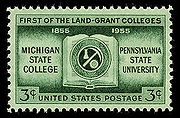
Agriculture School
| Month | Day | Year | Name change |
|---|---|---|---|
| February | 12 | 1855 | Agricultural College of the State of Michigan |
| March | 15 | 1861 | State Agricultural College |
| June | 2 | 1909 | Michigan Agricultural College (M.A.C.) |
| May | 1 | 1925 | Michigan State College of Agriculture and Applied Science (MSC) |
| July | 1955 | Michigan State University of Agriculture and Applied Science (MSU) | |
| January | 1964 | Michigan State University (MSU) |
The Michigan Constitution
Michigan Constitution
The Constitution of the State of Michigan is the governing document of the U.S. state of Michigan. It describes the structure and function of the state's government....
of 1850 called for the creation of an "agricultural school", either as a part of the University of Michigan
University of Michigan
The University of Michigan is a public research university located in Ann Arbor, Michigan in the United States. It is the state's oldest university and the flagship campus of the University of Michigan...
, or as an autonomous institution. U-M President Henry P. Tappan
Henry Philip Tappan
Henry Philip Tappan was an American philosopher, educator and academic administrator. He is officially considered the first president of the University of Michigan....
tried to convince the legislature to build the agriculture school in Ann Arbor
Ann Arbor, Michigan
Ann Arbor is a city in the U.S. state of Michigan and the county seat of Washtenaw County. The 2010 census places the population at 113,934, making it the sixth largest city in Michigan. The Ann Arbor Metropolitan Statistical Area had a population of 344,791 as of 2010...
, but the secretary of the Michigan State Agricultural Society, John C. Holmes
John Clough Holmes
John Clough Holmes was responsible for the establishment of Michigan State University. As the co-founder of the Michigan State Agricultural Society, John Clough Holmes spearheaded the movement to build an agriculture college in Michigan...
, argued that the young farmers would not get the attention they needed in the established university. Holmes' argument eventually won out and, on February 12, 1855, Michigan Governor Kinsley S. Bingham
Kinsley S. Bingham
Kinsley Scott Bingham was a U.S. Representative, a U.S. Senator, and the 11th Governor of the state of Michigan.-Early life in New York:...
signed a bill establishing the nation's first agriculture college, the Agricultural College of the State of Michigan.
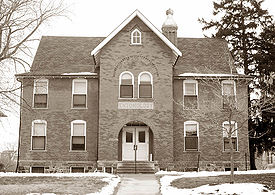
Joseph R. Williams
Joseph Rickelson Williams was an American politician and the first president for the Agricultural College of the State of Michigan, the first Land-Grant Institution to be established in the United States and now one of the largest universities in the United States, Michigan State University.-Early...
. Williams, a Harvard University
Harvard University
Harvard University is a private Ivy League university located in Cambridge, Massachusetts, United States, established in 1636 by the Massachusetts legislature. Harvard is the oldest institution of higher learning in the United States and the first corporation chartered in the country...
Phi Beta Kappa, was a self-made gentleman farmer and prominent Michigan attorney. He was a passionate promoter of higher education for the farming and working classes. In the first year, Williams hired several well-educated faculty members who had studied in prominent east coast schools. In cramped College Hall
College Hall (Michigan State University)
College Hall was the first building erected on the campus of the Agricultural College of the State of Michigan , and the first in the United States to be erected "for the teaching of scientific agriculture." Reputedly designed by John C...
, these scholars developed well-equipped laboratories with then-rare microscope
Microscope
A microscope is an instrument used to see objects that are too small for the naked eye. The science of investigating small objects using such an instrument is called microscopy...
s and other state-of-the-art scientific equipment. Under Williams, the College offered a unique blend of practical and theoretical academics.
With no prior American agricultural college on which to model itself, the College instead turned to the fledgling American medical school
Medical school
A medical school is a tertiary educational institution—or part of such an institution—that teaches medicine. Degree programs offered at medical schools often include Doctor of Osteopathic Medicine, Bachelor/Doctor of Medicine, Doctor of Philosophy, master's degree, or other post-secondary...
as a guide. In fact, a number of the early faculty members held medical degrees. As such, the school required more scientific study than other undergraduate institutions of the era. The school offered a three-part curriculum that balanced liberal arts
Liberal arts
The term liberal arts refers to those subjects which in classical antiquity were considered essential for a free citizen to study. Grammar, Rhetoric and Logic were the core liberal arts. In medieval times these subjects were extended to include mathematics, geometry, music and astronomy...
, science
Science
Science is a systematic enterprise that builds and organizes knowledge in the form of testable explanations and predictions about the universe...
and practical vocational studies. Somewhat unusual for the day, Williams excluded Latin and Greek
Greek language
Greek is an independent branch of the Indo-European family of languages. Native to the southern Balkans, it has the longest documented history of any Indo-European language, spanning 34 centuries of written records. Its writing system has been the Greek alphabet for the majority of its history;...
studies from the early curriculum. This meant that these classical languages were not admission requirements, a relief for the overwhelming number of rural applicants. The College did require three hours of daily manual labor, which helped students defray expenses and develop the campus infrastructure while students learned scientific principles through their efforts.
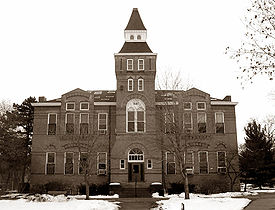
After resigning from the College, Williams was elected Michigan's lieutenant governor
Lieutenant governor
A lieutenant governor or lieutenant-governor is a high officer of state, whose precise role and rank vary by jurisdiction, but is often the deputy or lieutenant to or ranking under a governor — a "second-in-command"...
and helped pass the Reorganization Act of 1861. That new law mandated that the College have a four-year curriculum and the power to grant degrees comparable to those of the University of Michigan — that is, master's degree
Master's degree
A master's is an academic degree granted to individuals who have undergone study demonstrating a mastery or high-order overview of a specific field of study or area of professional practice...
s (and much, later, doctoral degrees
Doctorate
A doctorate is an academic degree or professional degree that in most countries refers to a class of degrees which qualify the holder to teach in a specific field, A doctorate is an academic degree or professional degree that in most countries refers to a class of degrees which qualify the holder...
). Under the act, a newly created body known as the State Board of Agriculture took over from the State Board of Education in running the institution. At that time, the legislature adopted the more pronouncible name of State Agricultural College.
The school's first class graduated in 1861, but there was no time for an elaborate graduation ceremony. The American Civil War had just begun, and the college's first class had been drafted into the war effort. The following year, U.S. President Abraham Lincoln
Abraham Lincoln
Abraham Lincoln was the 16th President of the United States, serving from March 1861 until his assassination in April 1865. He successfully led his country through a great constitutional, military and moral crisis – the American Civil War – preserving the Union, while ending slavery, and...
signed the Morrill Land-Grant Colleges Act
Morrill Land-Grant Colleges Act
The Morrill Land-Grant Acts are United States statutes that allowed for the creation of land-grant colleges, including the Morrill Act of 1862 and the Morrill Act of 1890 -Passage of original bill:...
to support similar colleges nationally, the first instance of federal funding for education. Williams, whose efforts as lieutenant governor had rescued the school from extinction, never witnessed this landmark occasion to which he had dedicated so much of his life, as he had become ill and died the year prior to the federal enactment.
Civil War and post-war period
| School year | Number of students |
|---|---|
| 1857–1858 | 63 |
| 1907–1908 | 1,100 |
| 1955–1956 | 44,836 |
In 1862 the newly created State Board of Agriculture appointed English Literature professor Theophilus Capen ("T.C.") Abbot
Theophilus C. Abbot
Theophilus Capen Abbot was president of State Agricultural College from 1862 to 1885...
president, much to the professor's surprise. Nevertheless, the soft-spoken Abbot remained president for twenty-two years and helped stabilize the College during and after the Civil War
American Civil War
The American Civil War was a civil war fought in the United States of America. In response to the election of Abraham Lincoln as President of the United States, 11 southern slave states declared their secession from the United States and formed the Confederate States of America ; the other 25...
. One of the College's main concerns was that its Morrill Act endowment
Financial endowment
A financial endowment is a transfer of money or property donated to an institution. The total value of an institution's investments is often referred to as the institution's endowment and is typically organized as a public charity, private foundation, or trust....
had attracted the University of Michigan's attention. Advocates for the University brought a bill before the State Legislature to merge with the Agricultural College and move the Lansing faculty and facilities to the Ann Arbor
Ann Arbor, Michigan
Ann Arbor is a city in the U.S. state of Michigan and the county seat of Washtenaw County. The 2010 census places the population at 113,934, making it the sixth largest city in Michigan. The Ann Arbor Metropolitan Statistical Area had a population of 344,791 as of 2010...
campus. UM leaders argued that it was necessary to share the Morrill Act income with the financially struggling UM. While the plan initially had broad support across the state, merger opponents pointed out that Ann Arbor had inadequate facilities for an agricultural education; a move to Ann Arbor would require so much investment capital as to make the UM plan financially untenable. The Legislature voted down UM's proposal in 1863, but it returned to the floor in 1865, 1867, and again in 1869. While the College successfully fended off each takeover attempt, the persistent threat that it might move kept the Legislature from appropriating any money for new campus construction at Lansing. As a result, the College was restricted to one boarding hall and enrollment was accordingly limited for many years thereafter.
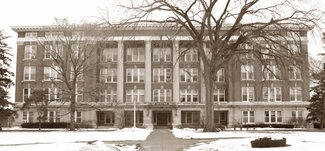
Botany
Botany, plant science, or plant biology is a branch of biology that involves the scientific study of plant life. Traditionally, botany also included the study of fungi, algae and viruses...
professor William J. Beal
William J. Beal
William James Beal was an American botanist.-Biography:Beal was born in Adrian, Michigan, to William and Rachel Beal, and he married Hannah Proud in 1863. He attended the University of Michigan, which gave him an A.B. degree in 1859 and an A.M. degree in 1862; he also received an S.B. degree...
, an early plant geneticist who invented a hardier strain of hybrid corn
Maize
Maize known in many English-speaking countries as corn or mielie/mealie, is a grain domesticated by indigenous peoples in Mesoamerica in prehistoric times. The leafy stalk produces ears which contain seeds called kernels. Though technically a grain, maize kernels are used in cooking as a vegetable...
through cross-fertilization
Cross-fertilization
Cross-fertilization can refer to:*Allogamy, where an ovum from one individual is fertilized with the spermatozoa of another*Heterosis, where different strains are cross-bred to form a hybrid...
. Beal corresponded with Charles Darwin
Charles Darwin
Charles Robert Darwin FRS was an English naturalist. He established that all species of life have descended over time from common ancestry, and proposed the scientific theory that this branching pattern of evolution resulted from a process that he called natural selection.He published his theory...
and championed the laboratory, or "inductive", teaching method. He conducted his classes in the first botanical laboratory building on an American campus. Another distinguished faculty member was the alumnus-turned-professor, Liberty Hyde Bailey
Liberty Hyde Bailey
Liberty Hyde Bailey was an American horticulturist, botanist and cofounder of the American Society for Horticultural Science.-Biography:...
. Often called the "Father of American Horticulture
Horticulture
Horticulture is the industry and science of plant cultivation including the process of preparing soil for the planting of seeds, tubers, or cuttings. Horticulturists work and conduct research in the disciplines of plant propagation and cultivation, crop production, plant breeding and genetic...
", Bailey was the first person to raise the study of horticulture to a science equal to botany.
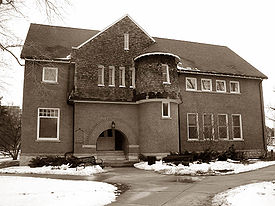
Cornell University
Cornell University is an Ivy League university located in Ithaca, New York, United States. It is a private land-grant university, receiving annual funding from the State of New York for certain educational missions...
, Yale
Yale University
Yale University is a private, Ivy League university located in New Haven, Connecticut, United States. Founded in 1701 in the Colony of Connecticut, the university is the third-oldest institution of higher education in the United States...
, Harvard
Harvard University
Harvard University is a private Ivy League university located in Cambridge, Massachusetts, United States, established in 1636 by the Massachusetts legislature. Harvard is the oldest institution of higher learning in the United States and the first corporation chartered in the country...
, England, France and Germany to continue their studies." Abbot also identified alumni who were teaching at land grant schools such as Cornell and the University of Wisconsin–Madison
University of Wisconsin–Madison
The University of Wisconsin–Madison is a public research university located in Madison, Wisconsin, United States. Founded in 1848, UW–Madison is the flagship campus of the University of Wisconsin System. It became a land-grant institution in 1866...
, and at reputable liberal arts colleges such as Oberlin
Oberlin College
Oberlin College is a private liberal arts college in Oberlin, Ohio, noteworthy for having been the first American institution of higher learning to regularly admit female and black students. Connected to the college is the Oberlin Conservatory of Music, the oldest continuously operating...
.
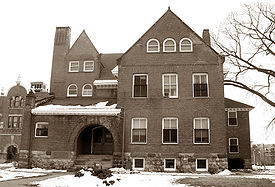
Albert Einstein
Albert Einstein was a German-born theoretical physicist who developed the theory of general relativity, effecting a revolution in physics. For this achievement, Einstein is often regarded as the father of modern physics and one of the most prolific intellects in human history...
; Ray Stannard Baker
Ray Stannard Baker
Ray Stannard Baker , also known by his pen name David Grayson, was an American journalist and author born in Lansing, Michigan...
, a famed turn of the 20th century "muckraker
Muckraker
The term muckraker is closely associated with reform-oriented journalists who wrote largely for popular magazines, continued a tradition of investigative journalism reporting, and emerged in the United States after 1900 and continued to be influential until World War I, when through a combination...
" journalist and Pulitzer Prize
Pulitzer Prize
The Pulitzer Prize is a U.S. award for achievements in newspaper and online journalism, literature and musical composition. It was established by American publisher Joseph Pulitzer and is administered by Columbia University in New York City...
winning biographer of Woodrow Wilson; and William Chandler Bagley, a pioneering education reformer. In the 1870s, foreign students began traveling to the United States to attend the Michigan State Agricultural College such that, by the 1880s, they were a significant presence on campus. In 1887, two percent (six out of 312) of the College’s student population were Japanese
Japanese people
The are an ethnic group originating in the Japanese archipelago and are the predominant ethnic group of Japan. Worldwide, approximately 130 million people are of Japanese descent; of these, approximately 127 million are residents of Japan. People of Japanese ancestry who live in other countries...
. Among the 1880s students were Michitaro Tsuda, (B.S.1884), who went on to become a member of the Japanese emperor’s Privy Council
Privy council
A privy council is a body that advises the head of state of a nation, typically, but not always, in the context of a monarchic government. The word "privy" means "private" or "secret"; thus, a privy council was originally a committee of the monarch's closest advisors to give confidential advice on...
, and Minakata Kumagusu
Minakata Kumagusu
was a Japanese author and naturalist.-Biography:Minakata was born in Wakayama, Wakayama Prefecture, Japan. In 1883, he moved to Tokyo, where he entered the preparatory school Kyōryū Gakkō. The headmaster of Kyōritsu, Takahashi Korekiyo, encouraged Minakata in his botanical studies as well as got...
, (1888), a prominent Japanese environmental scientist.
While the College had many successful alumni, many of Michigan farmers still feared that a college education would dissuade their children from agriculture. President Abbot helped win them over by taking the College to the farm. In 1876 the Agricultural College held the first "Farmers' Institutes" in rural communities across the state, where school professors shared experimental and practical information with Michigan farmers. This concept led to the Hatch Act of 1887
Hatch Act of 1887
The Hatch Act of 1887 gave federal funds, initially of $15,000 each, to state land-grant colleges in order to create a series of agricultural experiment stations, as well as pass along new information, especially in the areas of soil minerals and plant growth...
, which provided federal funding for agricultural experiment stations operated by each state's Land Grant college. Through these "Farmers' Institutes" (now the MSU Extension), T.C. Abbot converted many skeptical farmers into ardent College supporters.
Coed College
The College first admitted women in 1870 but the school's relative isolation and lack of women's living quarters tamped coeducational enrollment for decades. The few women who enrolled either boarded with faculty families or were locals who made the daily three-mile trek from Lansing by stagecoach over unpaved Michigan Avenue. The women were educated in the same scientific agriculture courses as men, excepting "practical agriculture." In 1896, the College became one of only fourteen other colleges and universities in America to adopt and meld a home economicsHome Economics
Home economics is the profession and field of study that deals with the economics and management of the home and community...
curriculum within the liberal arts and sciences program, increasing female enrollment. That same year, the school relocated male students from the old Abbot Hall dormitory in order to allow for greater a number of women to enroll in the course.
In 1885, in order to fill out its mandate as a Morrill Act college, the College established a Mechanics
Mechanical engineering
Mechanical engineering is a discipline of engineering that applies the principles of physics and materials science for analysis, design, manufacturing, and maintenance of mechanical systems. It is the branch of engineering that involves the production and usage of heat and mechanical power for the...
program which became the College's first full-fledged, degree-granting engineering program.

Tuskegee University
Tuskegee University is a private, historically black university located in Tuskegee, Alabama, United States. It is a member school of the Thurgood Marshall Scholarship Fund...
, founded and headed by Booker T. Washington
Booker T. Washington
Booker Taliaferro Washington was an American educator, author, orator, and political leader. He was the dominant figure in the African-American community in the United States from 1890 to 1915...
. Washington later delivered one of his most memorable addresses to the class of 1900 at commencement: in the 1900 commencement address, Booker T. Washington said "Without industrial development there can be no wealth; without wealth there can be no leisure; without leisure, no opportunity for thoughtful reflection and the cultivation of the higher arts.". MSU President Jonathan L. Snyder had invited Washington to be the College's Class of 1900 commencement speaker. A few years later, Myrtle Craig became the first African-American woman to enroll at the College. Graduating with the Class of 1907, she received her degree from U.S. President Theodore Roosevelt
Theodore Roosevelt
Theodore "Teddy" Roosevelt was the 26th President of the United States . He is noted for his exuberant personality, range of interests and achievements, and his leadership of the Progressive Movement, as well as his "cowboy" persona and robust masculinity...
, commencement speaker for the Semi-Centennial celebration of the College’s opening.
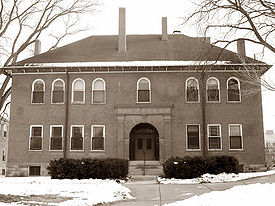
East Lansing, Michigan
East Lansing is a city in the U.S. state of Michigan. The city is located directly east of Lansing, Michigan, the state's capital. Most of the city is within Ingham County, though a small portion lies in Clinton County. The population was 48,579 at the time of the 2010 census, an increase from...
incorporated in 1907 as well. Two years later, the college officially changed its name to Michigan Agricultural College (M.A.C.), since by this time there were many other agricultural colleges across the country. Even though the College had been around for over fifty years and was a widely recognized leader of the Land Grant Colleges, some within the state legislature opposed expansion. Despite the Morrill Act’s original mandate that Land Grant Colleges teach engineering (then called “mechanic arts”), some in Michigan believed its agricultural college should not have engineering program because these duplicated the University of Michigan
University of Michigan
The University of Michigan is a public research university located in Ann Arbor, Michigan in the United States. It is the state's oldest university and the flagship campus of the University of Michigan...
's offerings. Nonetheless, M.A.C. had developed civil, and electrical engineering
Electrical engineering
Electrical engineering is a field of engineering that generally deals with the study and application of electricity, electronics and electromagnetism. The field first became an identifiable occupation in the late nineteenth century after commercialization of the electric telegraph and electrical...
programs to compliment the original mechanical program of 1885. These separate disciplines were unified in a new Department of Engineering in 1908.
When a 1916 fire destroyed M.A.C.’s nine-year-old engineering hall, there was a movement to have the entire program absorbed by the University of Michigan. Lansing automobile magnate Ransom E. Olds
Ransom E. Olds
Ransom Eli Olds was a pioneer of the American automotive industry, for whom both the Oldsmobile and REO brands were named. He claimed to have built his first steam car as early as 1894, and his first gasoline powered car in 1896...
, however, solidified the program on the East Lansing campus with a gift of $100,000 in 1917 for a new engineering building to be erected directly upon the foundations of the burned hall. The donation, the College's first significant private gift for a building, resulted in Olds Hall. The original building is still standing but now houses MSU’s University Relations division as well as classroom space.
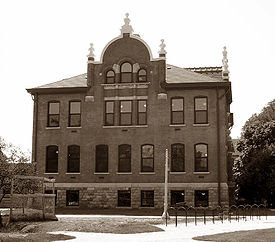
Cooperative extension service
The Cooperative Extension Service, also known as the Extension Service of the USDA, is a non-formal educational program implemented in the United States designed to help people use research-based knowledge to improve their lives. The service is provided by the state's designated land-grant...
. Like T.C. Abbot's initial "Farmers' Institutes", these extension services spread college-based knowledge about agriculture and related issues to citizens around the state. Such extension services served as the third prong of the Land Grant college mission of education, research and public service. With this new mandate, the College looked to expand its curriculum beyond agriculture and engineering. By 1925, the institution had expanded enough that it petitioned the state of Michigan to remove the word "agriculture" from its name, but the University of Michigan
University of Michigan
The University of Michigan is a public research university located in Ann Arbor, Michigan in the United States. It is the state's oldest university and the flagship campus of the University of Michigan...
opposed the name change. As a compromise, the state government decided to call it Michigan State College of Agriculture and Applied Science (M.S.C.). However, the College's athletic teams were still known as the "Aggies". Thus M.S.C. held a contest to find a new nickname. They decided to call the teams the "Michigan Staters". Local sports writers for the Lansing State Journal
Lansing State Journal
The Lansing State Journal is a daily newspaper published in Lansing, Michigan owned by Gannett.-Overview:The Lansing State Journal is the sole daily newspaper published in metropolitan Lansing...
and the Capital News went through the losing entries to find a shorter and more heroic name. They decided on the "Spartans
Spartan Army
The Spartan army was the military force of Sparta, one of the leading city-states of ancient Greece. The army stood at the centre of the Spartan state, whose citizens' primary obligation was to be good soldiers. Subject to military drill from infancy, the Spartans were one of the most feared...
". By coincidence, Justin Morrill had once compared the Land Grant colleges to the schools of ancient Sparta. With a heroic name and a historic precedent, the "Spartans" quickly caught on as the teams' new nickname. Within a few years, the College changed the lyrics of the Fight Song
Michigan State University Fight Song
The MSU Fight Song is the official fight song of Michigan State University, USA. MSU's fight song was created in early 1915 , when MSU was known as Michigan Agricultural College...
to reflect the name change of the College and its sports teams.
Big Ten University
| Year | Winning team | Winning score | Losing team | Losing score |
|---|---|---|---|---|
| 1954 | Michigan State | 28 | UCLA | 20 |
| 1956 | 17 | 14 | ||
| 1966 | UCLA | 14 | Michigan State | 12 |
| 1988 | Michigan State | 20 | Southern California | 17 |
In 1941, then-Secretary of the State Board of Agriculture John A. Hannah
John A. Hannah
John Alfred Hannah was president of Michigan State College for 28 years, making him the longest serving of MSU's presidents. He is credited with transforming the school from a little-known, regional agricultural college into a large national research institution...
, was appointed president of M.S.C. Hannah began the largest expansion in the school's history, aided by the G.I. Bill. Enacted in 1945, the law helped World War II
World War II
World War II, or the Second World War , was a global conflict lasting from 1939 to 1945, involving most of the world's nations—including all of the great powers—eventually forming two opposing military alliances: the Allies and the Axis...
veterans fund post-secondary educations. During this time the bulk of the South Campus was quickly built to allow for an ever-growing influx of students. One of Hannah's strategies was to build a new residence hall, enroll enough students to fill it and then use the income to start construction on a new dormitory. In the process the president built the nation's largest university housing system. Under Hannah's plan, enrollment increased from 15,000 in 1950 to 38,000 in 1965.

University of Chicago
The University of Chicago is a private research university in Chicago, Illinois, USA. It was founded by the American Baptist Education Society with a donation from oil magnate and philanthropist John D. Rockefeller and incorporated in 1890...
eliminated varsity football
American football
American football is a sport played between two teams of eleven with the objective of scoring points by advancing the ball into the opposing team's end zone. Known in the United States simply as football, it may also be referred to informally as gridiron football. The ball can be advanced by...
and withdrew from the Western Conference (now the Big Ten
Big Ten Conference
The Big Ten Conference is the United States' oldest Division I college athletic conference. Its twelve member institutions are located primarily in the Midwestern United States, stretching from Nebraska in the west to Pennsylvania in the east...
) in 1946, Hannah lobbied hard to take its place. The Big Ten finally admitted M.S.C. in 1949. After joining the conference, head football
American football
American football is a sport played between two teams of eleven with the objective of scoring points by advancing the ball into the opposing team's end zone. Known in the United States simply as football, it may also be referred to informally as gridiron football. The ball can be advanced by...
coach Clarence L. "Biggie" Munn
Biggie Munn
Clarence Lester "Biggie" Munn was an American football player, coach, and college athletics administrator in the United States. He was the head football coach at Albright College , Syracuse University , and most notably Michigan State College , where his 1952 squad won a national championship...
led the Spartan football team to the Rose Bowl
Rose Bowl Game
The Rose Bowl is an annual American college football bowl game, usually played on January 1 at the Rose Bowl in Pasadena, California. When New Year's Day falls on a Sunday, the game is played on Monday, January 2...
in the 1953–54 season, beating UCLA
University of California, Los Angeles
The University of California, Los Angeles is a public research university located in the Westwood neighborhood of Los Angeles, California, USA. It was founded in 1919 as the "Southern Branch" of the University of California and is the second oldest of the ten campuses...
28–20. Successor coach Hugh "Duffy" Daugherty
Duffy Daugherty
Hugh Duffy Daugherty was an American football player and coach. He served as the head coach at Michigan State University from 1954 to 1972, where he compiled a career record of 109–69–5. Duffy's 1965 and 1966 teams won national championships...
lead the football team to a second Rose Bowl where it again defeated UCLA, 17–14.
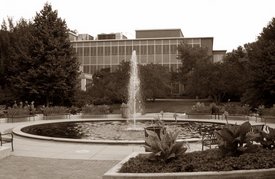
Michigan Constitution
The Constitution of the State of Michigan is the governing document of the U.S. state of Michigan. It describes the structure and function of the state's government....
of 1964. With this enactment, the university's governing body changed its name from the State Board of Agriculture to the Michigan State University Board of Trustees. Since 1964, the school has been known simply as Michigan State University.
In the 1960s MSU expanded its reputation as a world-grant university, including responding to the invitation of Nigerian President Nnamdi Azikiwe to partner with Nigerians to build the first land-grant model university in Africa, the University of Nigeria at Nsukka. The many years of faculty experience in Nigeria created the foundation for a major MSU African Studies Center http://africa.msu.edu/. By the 1990s MSU had the largest faculty in the nation of Africa specialists (170) and was producing more Ph.D.s on Africa, offering more study abroad in Africa (26), and teaching more African languages (30) than any other university. The faculty is deeply engaged in many African development problems in food security, health (especially tropical diseases such as malaria, river blindness, and filariasis), education, and gender equity. In 1978, MSU divested
Divestment
In finance and economics, divestment or divestiture is the reduction of some kind of asset for either financial or ethical objectives or sale of an existing business by a firm...
the stocks of companies doing business in apartheid-governed South Africa from its endowment portfolio.
By 1969, the student body had become politically active over issues such as civil rights
Civil rights
Civil and political rights are a class of rights that protect individuals' freedom from unwarranted infringement by governments and private organizations, and ensure one's ability to participate in the civil and political life of the state without discrimination or repression.Civil rights include...
and the Vietnam War
Vietnam War
The Vietnam War was a Cold War-era military conflict that occurred in Vietnam, Laos, and Cambodia from 1 November 1955 to the fall of Saigon on 30 April 1975. This war followed the First Indochina War and was fought between North Vietnam, supported by its communist allies, and the government of...
. Protests led to the resignation of President John A. Hannah
John A. Hannah
John Alfred Hannah was president of Michigan State College for 28 years, making him the longest serving of MSU's presidents. He is credited with transforming the school from a little-known, regional agricultural college into a large national research institution...
and the blocking of the construction of Interstate 496
Interstate 496
Interstate 496 is an Interstate Highway that passes through downtown Lansing, Michigan and is a "child" of Interstate 96. It is ceremonially designated the R.E. Olds Freeway along the portion that cuts through the city of Lansing...
through the campus. In 1970, the Board of Trustees appointed President Clifton Wharton
Clifton R. Wharton, Jr.
Clifton Reginald Wharton, Jr. is an American economist, foundation official, university president, and corporate executive who served briefly as United States Deputy Secretary of State during the Clinton Administration.-Biography:...
, MSU's first African-American president and the first minority president of a major public American university. Under Wharton, the University created co-ed residence halls and residential college
Residential college
A residential college is an organisational pattern for a division of a university that places academic activity in a community setting of students and faculty, usually at a residence and with shared meals, the college having a degree of autonomy and a federated relationship with the overall...
s. In 1988, the university won its third Rose Bowl, this time beating USC
University of Southern California
The University of Southern California is a private, not-for-profit, nonsectarian, research university located in Los Angeles, California, United States. USC was founded in 1880, making it California's oldest private research university...
20–17.
Post-Vietnam War and today
| President | Start year | End year |
|---|---|---|
| Joseph R. Williams Joseph R. Williams Joseph Rickelson Williams was an American politician and the first president for the Agricultural College of the State of Michigan, the first Land-Grant Institution to be established in the United States and now one of the largest universities in the United States, Michigan State University.-Early... |
1857 | 1859 |
| Lewis R. Fiske Lewis R. Fiske Lewis Ransom Fiske was an educator from the U.S. state of Michigan. He served as president pro tempore of the Agricultural College of the State of Michigan from 1859 to 1862 and as president of Albion College from 1877 to 1898... |
1859 | 1862 |
| Theophilus C. Abbot Theophilus C. Abbot Theophilus Capen Abbot was president of State Agricultural College from 1862 to 1885... |
1862 | 1885 |
| Edwin Willits Edwin Willits Edwin Willits was a politician from the U.S. State of Michigan.Willits was born in Otto, New York and moved to Michigan with his parents in September 1836. He graduated from the University of Michigan at Ann Arbor in June 1855. The following April he settled in Monroe, Michigan where he was... |
1885 | 1889 |
| Oscar Clute Oscar Clute Oscar Clute was president of Michigan's State Agricultural College from 1889 to 1893.-External links:*... |
1889 | 1893 |
| Lewis G. Gorton Lewis G. Gorton Lewis G. Gorton was president of the State Agricultural College from 1893 to 1895.-External links:*... |
1893 | 1895 |
| Jonathan L. Snyder Jonathan L. Snyder Jonathan L. Snyder was president of the State Agricultural College from 1896 to 1915... |
1896 | 1915 |
| Frank S. Kedzie Frank S. Kedzie Frank S. Kedzie was president of the Michigan Agricultural College from 1915 to 1921. Kedzie Hall, on campus on the north side of the Red Cedar River is named in his honor.-External links:... |
1915 | 1921 |
| David Friday David Friday David Friday was president of the Michigan Agricultural College from 1922 to 1923.Friday was a graduate of the University of Michigan.During his presidency Michigan State first granted a Ph.D.-External links:... |
1922 | 1923 |
| Kenyon L. Butterfield Kenyon L. Butterfield Kenyon Leech Butterfield was an American agricultural scientist and college administrator known for developing the Cooperative Extension Service at the Land Grant Universities, and was instrumental in developing the Smith-Lever Act of 1914... |
1924 | 1928 |
| Robert S. Shaw Robert S. Shaw Robert Sidney Shaw was president of the Michigan State College of Agriculture and Applied Science from 1928 to 1941. The dormitory Shaw Hall in the center of campus south of the Red Cedar River is named in his honor.-External links:*... |
1928 | 1941 |
| John A. Hannah John A. Hannah John Alfred Hannah was president of Michigan State College for 28 years, making him the longest serving of MSU's presidents. He is credited with transforming the school from a little-known, regional agricultural college into a large national research institution... |
1941 | 1969 |
| Walter Adams Walter Adams (economist) Walter Adams was an American economist and college professor. He served as the 13th President of Michigan State University and served as an expert witness before 36 congressional committees.-Early life:... |
1969 | 1970 |
| Clifton R. Wharton, Jr. Clifton R. Wharton, Jr. Clifton Reginald Wharton, Jr. is an American economist, foundation official, university president, and corporate executive who served briefly as United States Deputy Secretary of State during the Clinton Administration.-Biography:... |
1970 | 1978 |
| Edgar L. Harden Edgar L. Harden Edgar L. Harden was the president of Michigan State University from 1977 to 1979.-External links:*... |
1978 | 1979 |
| M. Cecil Mackey M. Cecil Mackey M. Cecil Mackey was the president of University of South Florida from 1971 to 1976, Texas Tech University from 1976 to 1979, and Michigan State University from 1979 to 1985.... |
1979 | 1985 |
| John A. DiBiaggio John A. DiBiaggio John Angelo DiBiaggio was president of the University of Connecticut from 1979 to 1985, then president of Michigan State University from 1985 to 1992, and president of Tufts University from 1992 to 2001.-External links:... |
1985 | 1992 |
| Gordon Guyer Gordon Guyer Gordon Earl Guyer was president of Michigan State University from 1992 to 1993.-External links:*... |
1992 | 1993 |
| M. Peter McPherson M. Peter McPherson M. Peter McPherson was a special assistant to President Gerald Ford, head of USAID under President Ronald Reagan, president of Michigan State University from 1993 to 2004, and Chairman of Dow Jones beginning in 2007.... |
1993 | 2004 |
| Lou Anna K. Simon | 2005 | current |
As the pioneer land grant university, MSU has historically sought to provide educational opportunities to a wide variety of students, especially to those from the farming and working classes. Former President Peter McPherson stated "access to MSU and the education it offers is one of our roots” while noting the challenge, even irony, in maintaining such openness as the University’s quality makes it ever more popular and difficult to be admitted into. In the 2004 State of the University Address MSU President M. Peter McPherson stated: "At Michigan State, we are elite. But we are not elitist.". In more recent years, "town and gown
Town and gown
Town and gown are two distinct communities of a university town; "town" being the non-academic population and "gown" metonymically being the university community, especially in ancient seats of learning such as Oxford, Cambridge, Durham and St Andrews, although the term is also used to describe...
" relations have soured as students and permanent residents looked at each other with increasing hostility. This erupted in clashes involving the police in 1997, 1998, and 1999. Local and national news referred to the disturbances as riots. After several years without any major incidents, another disturbance broke out on April 2, 2005 after the North Carolina
University of North Carolina at Chapel Hill
The University of North Carolina at Chapel Hill is a public research university located in Chapel Hill, North Carolina, United States...
's men's basketball team defeated MSU in the 2005 NCAA
National Collegiate Athletic Association
The National Collegiate Athletic Association is a semi-voluntary association of 1,281 institutions, conferences, organizations and individuals that organizes the athletic programs of many colleges and universities in the United States...
Final Four
Final four
Final Four isa sports term that is commonly applied to the last four teams remaining in a playoff tournament, most notably NCAA Division I college basketball tournaments. The term usually refers to the four teams who compete in the two games of a single-elimination tournament's semi-final round...
. Officially called a "civil disturbance," the ensuing violence sparked accusations of police brutality
Police brutality
Police brutality is the intentional use of excessive force, usually physical, but potentially also in the form of verbal attacks and psychological intimidation, by a police officer....
in East Lansing.
More recently, East Lansing's plan to redevelop Cedar Village (a student-dominated neighborhood at the center of several riots) has increased the tensions between the school and local government. In 2005, East Lansing City Council declared the neighborhood "blighted", and proposed to redevelop the 35 acres (14.2 ha) site as a complex of upscale condominiums and retail stores called East Village. Several fraternities
Fraternities and sororities
Fraternities and sororities are fraternal social organizations for undergraduate students. In Latin, the term refers mainly to such organizations at colleges and universities in the United States, although it is also applied to analogous European groups also known as corporations...
in the affected area mounted a campaign against the redevelopment plan.
Looking to improve its academic reputation in the 21st century, current president Lou Anna Simon
Lou Anna Simon
Lou Anna Kimsey Simon is the 20th and current president of Michigan State University in East Lansing, Michigan. Simon is chair of the Big Ten's Council of Presidents/Chancellors.-Education:...
called in September, 2004 for MSU to become the "global leader" of Land Grant institutions by the year 2012. These plans include creating a new residential college
Residential college
A residential college is an organisational pattern for a division of a university that places academic activity in a community setting of students and faculty, usually at a residence and with shared meals, the college having a degree of autonomy and a federated relationship with the overall...
(the Residential College in Arts & Humanities
Residential College in Arts & Humanities
The Residential College in Arts & Humanities is a new residential college at Michigan State University in East Lansing Michigan. Founded October 21, 2005, the college provides around 600 undergraduates with an individualized curriculum in the liberal, visual and performing arts...
), investing in biotechnology
Biotechnology
Biotechnology is a field of applied biology that involves the use of living organisms and bioprocesses in engineering, technology, medicine and other fields requiring bioproducts. Biotechnology also utilizes these products for manufacturing purpose...
research, and increasing National Institutes of Health
National Institutes of Health
The National Institutes of Health are an agency of the United States Department of Health and Human Services and are the primary agency of the United States government responsible for biomedical and health-related research. Its science and engineering counterpart is the National Science Foundation...
donations above the $100 million mark. As part of these plans the university sought and was awarded the Facility for Rare Isotope Beams by the Department of Energy in 2008. The $550 million facility will study the properties of rare isotopes and better allow scientists to study origins of elements
Michigan State websites
- Main university site
- Michigan State University Museum
- MSU Archives & Historical Collections
- MSU Campus Buildings That No Longer Exist
- On the Banks of the Red Cedar Collections
- MSU Facts
External websites
- A Brief History of East Lansing, Michigan includes a chronology of campus buildings during the M.A.C. years.
- Artifacts from Michigan Agricultural College - A private collection
- Association of American Universities website
- Morrill Act and related resources at the Library of Congress

